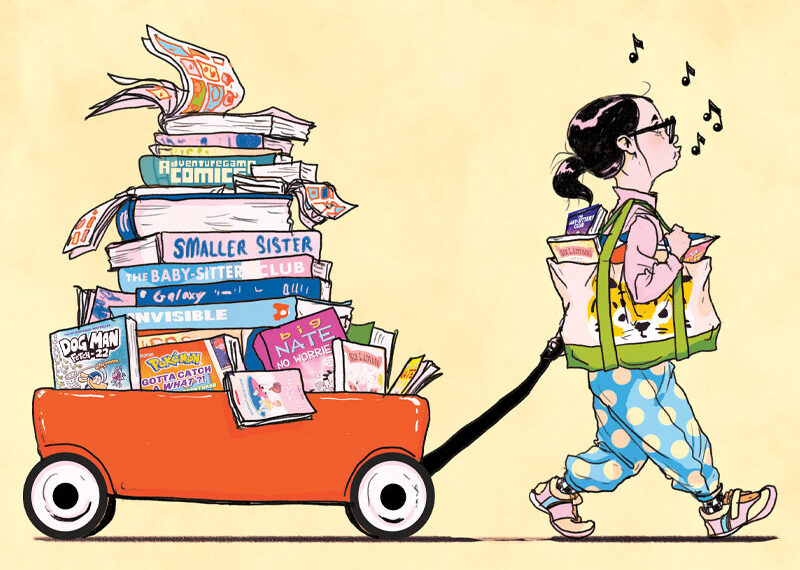Table of Contents
ToggleIntroduction
The Boom Of Graphic Novels In Education One of the literary genres with the greatest rate of growth in the field of education in recent years is graphic novels. Graphic novels, which were once thought of as entertainment and frequently written off as “comic books,” are now acknowledged as effective teaching resources for a wide range of subjects, including science, social sciences, literature, and history.
Combining text and visual art has changed the way that students interact with the material by providing fresh perspectives on difficult concepts, encouraging creativity, and improving literacy.
A change in educational philosophy that acknowledges the value of visual literacy in addition to traditional reading and writing is what is causing graphic novels to become more and more popular in classrooms.
Because of their ability to combine narrative with vibrant, expressive art, graphic novels have become popular both as stand-alone reading materials and as essential teaching tools in classrooms. They engage reluctant readers, help students grasp abstract ideas, and even spark new creative endeavors.
The Rise of Graphic Novels: A New Era of Literacy
1. What Are Graphic Novels?
The idea of a “graphic novel” is not new, even though the phrase has just lately become widely used. A graphic novel is a book-length work that combines story and visual art in the style of a comic book. Graphic novels are self-contained narratives that can span a variety of genres, including non-fiction, historical fiction, fantasy, and science fiction, in contrast to traditional comics, which are usually serialized and shorter in length.
The medium gained greater prominence in the 1980s and 1990s with landmark works like Art Spiegelman’s Maus, a poignant recounting of his father’s experiences in the Holocaust, and Marjane Satrapi’s Persepolis, an autobiographical account of growing up during the Iranian Revolution. These works not only changed the public’s perception of graphic novels but also proved that this medium could be used to tackle serious themes and complex narratives.
In educational settings, graphic novels have been increasingly used for their unique ability to engage students who may struggle with traditional texts. By combining written text with visual elements, graphic novels offer an alternative mode of learning that appeals to both visual learners and reluctant readers.

2. The Growth of Graphic Novels in the Publishing World
Over the past two decades, graphic novels have experienced a meteoric rise in popularity, both commercially and within the literary community. According to the American Association of Publishers, the graphic novel market has grown significantly year over year, with sales continuing to rise. In fact, graphic novels were one of the top-performing categories in the book industry in the 2020s.
The growing success of graphic novels can be attributed to several factors, including the expansion of the genre to include a broader range of subjects, including memoirs, biographies, and historical narratives. Furthermore, high-quality graphic novels are now being published by major book publishers, which has helped solidify their place as legitimate works of literature. Graphic novels have also benefited from the increasing popularity of comics in mainstream culture, especially with the success of comic-based films, TV series, and digital comics.
As the genre grows, educators have begun to realize the potential of graphic novels as an instructional tool. Teachers are now integrating graphic novels into classrooms, seeing the benefits they offer in engaging students, fostering creativity, and supporting literacy skills development.
Read more
Why Are Graphic Novels Becoming So Popular in Education?
1. Engagement and Accessibility
Graphic novels hold a unique place in the classroom because they can captivate students’ attention in ways traditional texts often cannot. For students who struggle with reading or those who have difficulty with text-heavy books, the visual nature of graphic novels provides an accessible alternative that allows them to engage with the material in a more dynamic and enjoyable way. The combination of images and text helps to clarify meaning and provides visual context that enhances understanding.
For reluctant readers, graphic novels often serve as an entry point into the world of literature. The engaging and colorful nature of these books can motivate students who may otherwise be disengaged with reading. Graphic novels can also provide a sense of accomplishment, as they often contain fewer words than traditional books, allowing students to finish a book quickly and gain a sense of progress.
Moreover, graphic novels are particularly appealing to visual learners, who may struggle with purely text-based material. Studies show that many students retain information better when visual and textual cues work in tandem. Graphic novels utilize this approach by integrating illustrations that help clarify plot developments, character emotions, and settings. This can deepen understanding, especially for complex or abstract concepts.
2. Supporting Critical Thinking and Comprehension
The use of visual storytelling in graphic novels has a profound impact on the development of critical thinking skills. When students engage with graphic novels, they must analyze both the text and the artwork. They need to interpret visual elements like facial expressions, body language, and environmental context, as these cues are often just as important as the written words in conveying meaning.
This dual analysis sharpens comprehension skills and encourages students to think more critically about how information is presented. In particular, the layout and sequencing of panels in graphic novels teach students to pay attention to how visual storytelling can impact the pacing and flow of a narrative. The interplay between images and text offers multiple layers of meaning that students can interpret and analyze.
Moreover, the combination of narrative and imagery in graphic novels helps students understand complex, abstract concepts. For instance, graphic novels can simplify complex historical events, scientific principles, or emotional experiences, making them more relatable and easier to grasp.
3. Diverse Representation and Perspectives
Graphic novels offer a valuable platform for diverse representation. With their ability to tell stories in a visual and narrative format, graphic novels can depict a wide range of characters, experiences, and cultural backgrounds. Many graphic novels focus on underrepresented groups, bringing issues such as racial inequality, mental health, LGBTQ+ rights, and immigration into the classroom in ways that are relatable and accessible.
For example, American Born Chinese by Gene Luen Yang deals with issues of race and identity in a way that is both humorous and poignant. El Deafo by Cece Bell explores the experience of growing up deaf, while The Arrival by Shaun Tan tells the story of immigration through a wordless narrative. These graphic novels not only broaden students’ perspectives but also foster empathy and understanding of different lived experiences.
By providing students with characters and stories they can relate to, graphic novels create an inclusive learning environment where students can see themselves reflected in the material. Additionally, they encourage students to explore perspectives that may be different from their own, promoting cultural awareness and empathy.
4. Improving Literacy and Writing Skills
Contrary to the belief that graphic novels might undermine literacy, research suggests that they can be a significant tool for enhancing writing and literacy skills. Graphic novels require students to understand sentence structure, grammar, vocabulary, and dialogue, all while analyzing how these elements work together with visual cues to tell a story. In fact, educators are increasingly using graphic novels to teach narrative techniques, literary devices, and even non-fiction writing skills.
By encouraging students to write their own graphic novels, teachers can help them build both creative writing and visual storytelling skills. The process of creating a graphic novel requires students to plan and organize their thoughts, develop characters, and sequence events in a way that makes sense both visually and narratively. As students engage with the writing and artistic components of graphic novels, they learn important skills such as pacing, theme development, and audience engagement.
Integrating Graphic Novels into the Classroom
1. Subject-Specific Uses
Graphic novels can be used across a wide range of subjects, not just English and Language Arts. Teachers are incorporating them into various aspects of the curriculum to make lessons more engaging and approachable.
- History and Social Studies: Graphic novels can help students better understand historical events and figures. For example, The March Trilogy by John Lewis is a powerful recounting of the Civil Rights Movement, while Persepolis offers a first-hand perspective on the Iranian Revolution. These books bring history to life and help students connect emotionally with historical events.
- Science: Graphic novels are also being used in subjects like biology, physics, and astronomy. Books like The Manga Guide to Physics and The Manga Guide to Molecular Biology combine entertaining storytelling with educational content, making complex scientific concepts easier to understand and remember.
- Math: Though not as commonly used, there are graphic novels designed to teach math concepts, particularly in a visual and practical manner. These include books like The Manga Guide to Linear Algebra, which uses manga characters to explain mathematical theories in an approachable format.
- Social-Emotional Learning (SEL): Graphic novels are increasingly being used to address mental health and emotional intelligence in the classroom. Books like Roller Girl by Victoria Jamieson and Smile by Raina Telgemeier provide students with stories about friendship, resilience, and overcoming personal challenges, which are key elements of SEL.
Read more
2. Classroom Activities and Projects
Teachers can incorporate graphic novels into a variety of engaging classroom activities. For instance, students can create their own graphic novels or comic strips as part of a writing project, allowing them to apply literary concepts in a creative and hands-on way. They can also analyze existing graphic novels for literary elements, such as plot structure, symbolism, and character development.
Additionally, students can explore the art of visual storytelling by learning how to create their own illustrations and understand the role of color, layout, and composition in conveying meaning. These activities can be adapted for all grade levels and have been shown to foster teamwork, communication, and critical thinking.
Challenges and Criticisms
Despite their growing popularity, there are some challenges and criticisms regarding the use of graphic novels in education.
- Perceptions of Legitimacy: Some educators and parents still perceive graphic novels as “less serious” than traditional books. They may dismiss them as mere entertainment or feel they are not “real” literature. Overcoming this perception is an ongoing challenge.
- Limited Resources: Not all schools have access to graphic novels or the resources to integrate them into their curriculum. While many schools are beginning to embrace the medium, others may be constrained by budget limitations, lack of teacher training, or resistance to change.
- Content Concerns: Some graphic novels deal with mature or controversial themes, which can be a point of concern for educators, parents, and school administrators. While many graphic novels are age-appropriate, careful selection is essential to ensure that content is suitable for the student population.
Conclusion
The rise of graphic novels in education represents a significant shift in how we approach literacy, learning, and engagement in the classroom. Graphic novels offer an accessible, engaging, and effective way to teach students important academic concepts, while also fostering creativity, empathy, and critical thinking. As the medium continues to evolve and gain acceptance in schools, it is clear that graphic novels have a powerful role to play in the future of education.
By embracing this dynamic and innovative form of storytelling, educators can provide students with a more inclusive, engaging, and comprehensive learning experience. The boom of graphic novels in education is not just a passing trend but a meaningful shift in how we approach literature, learning, and the development of young minds.
Read more
FAQ
1. Are graphic novels appropriate for all age groups?
Yes, graphic novels come in a variety of genres and styles, making them suitable for all age groups. There are graphic novels for children, teens, and adults, with themes ranging from adventure and fantasy to historical events and social issues.
2. How do graphic novels improve literacy skills?
Graphic novels help improve literacy skills by engaging students with both text and visuals, requiring them to analyze how words and images work together to convey meaning. This dual engagement enhances comprehension, critical thinking, and narrative skills.
3. Can graphic novels be used for teaching other subjects besides English?
Absolutely! Graphic novels are being used across subjects such as history, social studies, science, and even mathematics. They provide a visual and engaging way to explore complex concepts and events.
4. Are graphic novels considered “real” literature?
Yes, many graphic novels are considered legitimate works of literature, often exploring complex themes, intricate characters, and sophisticated narratives. Works like Maus and Persepolis have received critical acclaim and have been recognized with prestigious literary awards.
5. What are the benefits of using graphic novels in the classroom?
Graphic novels help engage reluctant readers, improve literacy and comprehension skills, promote creativity, foster empathy, and offer diverse representations of cultures and experiences. They also provide an interactive learning experience that encourages critical thinking and analysis.



